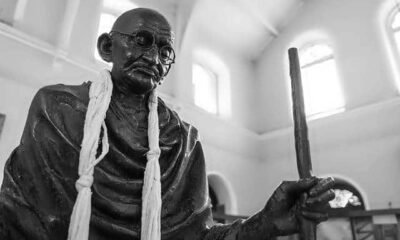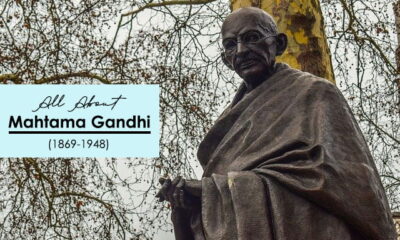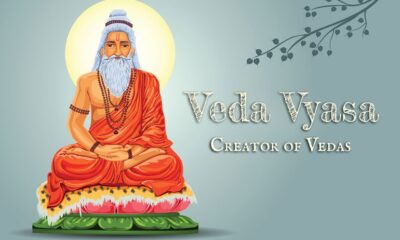Culture
Folk Dances of India: State-wise List

Folk Dances of India
India is a country of various cultures with a variety of languages, religions, dance, music, architecture, food, and customs. Indian folk and tribal dances are the way to express joy for people in their regions on every possible occasion. It may be a celebration of the arrival of seasons, a wedding and festivals, birth of a child. Every folk dance is associated with a particular dressing code of men and women.
Indian folk dance ranges over various customs and territorial styles. Bhangra of the Punjab, Garba, and Dandiya of Gujarat, Ghoomar of Rajasthan, the Bihu of Assam, the Chhau of West Bengal and Jharkhand, Sambalpuri of Odisha, and the Lavani of Maharashtra are among the better-known folk dances of India.
Bharatanatyam of Tamil Nadu, Kathak of Uttar Pradesh, Kathakali and Mohiniyattam of Kerala, Kuchipudi of Andhra Pradesh, Manipuri of Manipur, Odissi of Odisha, and the Sattriya of Assam, These are the eight classical folk dance forms including a lot of narrative forms and mythological elements specified by India’s Sangeet Natak Akademi (The National Academy for Music, Dance, and Drama).
Folk Dances of India
Below is the state-wise list of all the Folk Dances of India:
| Folk Dances | State |
|---|---|
| Andhra Pradesh | Kuchipudi (Classical), Mohiniattam, Ghantamardala, Ottam Thedal, Kummi, Siddhi Madhuri, Chhadi. |
| Arunachal Pradesh | Mask dance, War dance |
| Assam | Bihu, Naga dance, Bichhua, Natpuja, Maharas, Kaligopal, Bagurumba, Khel Gopal Tabal Chongli, Canoe, Jhumura Hobjanai |
| Bihar | Jata-Jatin, Bakho-Bakhain, Panwariya, Sama-Chakwa, Bidesia, Jatra |
| Chhattisgarh | Goudi, Jhumar, Karma, Dagla, Pali, Navrani, Diwari, Tapali, Mundari |
| Goa | Tarangamel, Dashavatara, Dekhni, Dhalo, Dhangar, Fugdi, Ghodemodni, Goff, Jagar, Kunbi, Mando, Muslam Khel, Perni Jagar, Ranamale, Romta Mel, Divlyan Nach (Lamp dance), Veerabhadra |
| Gujarat | Garba, Dandiya Ras, Tippani Juriun, Bhavai |
| Haryana | Jhumar, Phag Dance, Daph, Dhamal, Loor, Gugga, Khor, Gagor |
| Himachal Pradesh | Chamba, Chhapeli, Jhora, Jhali, Chharhi, Dhaman, Mahasu, Nati, Dangi, Thali, Jhainta, Daf, Stick dance |
| Jammu & Kashmir | Rauf, Hikat, Mandjas, Kud Dandi Nach, Damali |
| Jharkhand | Chhau, Sarahul, Jat-Jatin, Karma, Danga, Bidesia, Sohrai |
| Karnataka | Yakshagan, Huttari, Suggi, Kunitha, Karga, Lambi |
| Kerala | Kathakali (Classical), Rakhal, Nat Rash, Maha Rash, Raukhat |
| Maharashtra | Lavani, Nakata, Koli, Dahikala Dasavtar or Bohada, Tamasha, Lezim, Gafa, Mauni, Powara, Gouricha |
| Manipur | Manipuri (Classical), Rakhal, Nat Rash, Maha Rash, Raukhat |
| Meghalaya | Laho, Baagla |
| Mizoram | Khanatm, Pakhupila, Cherokan |
| Nagaland | Chong, Khaiva, Lim, Nuralim |
| Odisha | Odissi (Classical), Rakhal, Nat Rash, Maha Rash, Raukhat |
| Punjab | Bhangra, Giddha, Daff, Dhaman |
| Rajasthan | Ghumar, Ganagor, Jhulan Leela, Jhuma,Chakri, Suisini, Ghapal, Panihari, Ginad |
| Tamil Nadu | Bharatnatyam, Kumi, Kolattam, Kavadi |
| Uttara Khand | Gadhwali, Kumayuni, Kajari, Jhora, Raslila, Chappeli |
| Uttar Pradesh | Nautanki, Raslila, Kajri, Jhora, Chappeli, Jaita |
| West Bengal | Kathi, Gambhira, Dhali, Jatra, Baul, Marasia, Mahal, Keertan |

Culture
Indus Valley Civilisation: Relation with the Aryans & Vedic Culture

Indus Valley Civilisation: Almost 100 years ago when the excavation of Harappa and Mohenjodaro began, it led to the recognition that these two cities of Punjab were the earliest cities of India, and two of the earliest in the world.
The Indus Valley Civilisation
The approximate period of Indus Valley Civilisation appears to have flourished between 2000 to 1700 B.C. The first known civilization in India is called the Indus Valley Civilisation because the important sites which were excavated first are located in the valley of Indus.
The civilization appears to have spread over Punjab, Sindh, Rajasthan, Gujarat, and Baluchistan. The most significant feature of the Indus Valley Civilisation has burnt brick buildings. The “Great Bath” was found in Mohen-jo-Daro. Mohen-jo-Daro is also known as “Mound of the Dead”. The Indus people were probably ruled by merchants.
The script used by the Indus Valley people has not yet been deciphered. The first metal to be discovered and used for making tools was copper. Iron was not known to the people of Indus Valley Civilisation. Rice cultivation is associated with the Harappan site of Lothal. Mohen-jo-Daro and Harappa are not in India at present, they came under Pakistan after the 1947 division. According to historians, there were close commercial and cultural contacts between Indus Valley and the Sumerian Civilisation.
The Indus Valley people had not learned to domesticate horses, but those who lived in the Vedic age did make use of the horse. Wheat was the staple food of the Indus people. The Indus Valley people worshipped Pasupathi. The Indus Valley people venerated the bull. It was believed to be non-Aryan in its earlier historical development because it had a pictographic script, but modern historians are not unanimous on the fact.
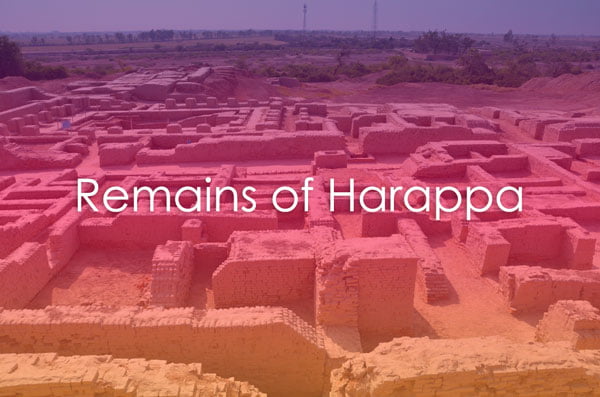
Harappa and Mohenjo Daro produced the basic cultural markers by which other settlements subsequently found could be identified as belonging to the Indus Valley civilization. These defining features can be listed as follows:
1. Wheel-made pottery of a distinctive kind: baked to a red color, thick-walled, heavy, sometimes coated with a red slip. Some pots were painted black; and there were certain popular motifs painted in black on the pottery, such as the pipal leaf, intersecting circles, and the peacock.
2. The Indus script, especially appearing on seals, with characters that show practically no regional variations.
3. Baked bricks, as well as sun-dried mud-bricks of standard size, with sides in the ratio of 1:2:4.
4. Standard weights, based apparently on a unit of 13.63 grams.
5. A tendency to lay out straight roads (meeting others at right angles) in urban and semi-urban settlements, and to pay considerable attention to drainage.
6. Citadels built adjacent to, but separate from, the towns.
7. Masonry wells and tanks.
8. Burying the dead, laid supine, aligned north-south, usually in out-of-town cemeteries.

The Vedic Culture & Aryans
The Aryans came to India from Central Asia. The Rig Vedic Aryans were largely urban people. The first home of the Aryans was Punjab. The Rig Vedic Aryans were generally under a monarchical Government. Copper was first used by the Vedic people.
The religious books of the Aryans are four in number (1) the Rig Veda, the oldest (2) the Yajur Veda (3) the Sama Veda (4) the Atharvana Veda. The Epics – the Ramayana and the Mahabharata. Mahabharata is the longest epic in the world, the Puranas – 18 in number; the Shastras or the Darshanas – six in number and the Manu.
Upanishads are books in Philosophy. They were translated into Persian, during the reign of Shah Jahan. The Aryans were skillful farmers. They knew the art of domesticating animals. They were engaged in trade and knew maritime navigation.
It has been a long dispute since the discovery of Harappa whether Indus Valley Civilisation was Pre-Vedic, Vedic, or Post-Vedic. It is also a subject of debate if this beautiful culture was devastated by the Aryans or not?
Generally, it was an established theory in the public through early discoveries that Vedic People or Aryans came to the Punjab region from the Persian region. They attacked the Indus Valley Civilisation, devastated it, and settled their colonies onwards. But the recent discoveries of scholars do not seem to be unanimous on these theories.
With a large number of calibrated carbon dates now available, the end of the Indus civilization in its main parts cannot be put later than 1900 BC; and this date is more than 400 years too early for the earliest elements in the Rigveda, the earliest Vedic composition. That the intruders, or some of them, were pre-Vedic Aryans’, that is, speakers of some form of proto-Aryan speech (out of which the language of the Rigveda developed later), is not impossible, but cannot be proved.
During the 1990s, an assertion began to be very widely made (and it has lately received much official encouragement), that the Indus civilization was not only Aryan but also Vedic or even post-Vedic. Some professional archaeologists have embraced the view, though it may be quite contrary to what they had held earlier.
A reason for claiming that the Indus civilization was Rigvedic has been found in the fact that the various Indus basin river names, occurring in the River Hymn of the Rigveda, appear to have ‘Aryan’ roots. It is argued that had the Indus civilization preceded the Rigveda and been non-Aryan, it would have left behind at least some non-Aryan river names in the Indus basin. The assumption here is that when languages change, river names are yet retained; but one can easily show that such has not often been the case.
So, what basically we are trying to say it is quite irresponsible to declare Indus Valley Civilisation a Vedic Culture in the light of available facts.
Architecture
Top 10 most famous landmarks in USA that everyone must visit
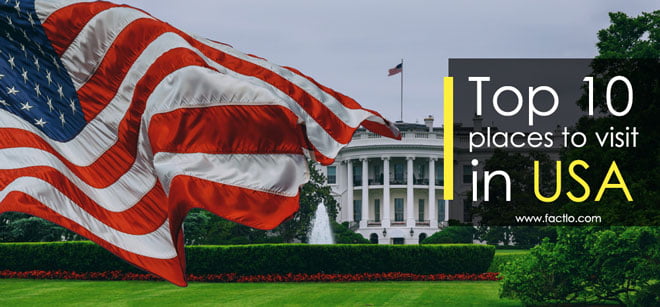
Famous Landmarks in the USA: A landmark basically means something conspicuous that marks a place. It can be anything that’s easily recognized from a distance, that has historical, cultural, or aesthetic importance. It could be a natural feature of a landscape or even a man-made structure. We use the word ‘landmark’ also to mean a significant event to mark a turning point.
The United States is the world’s third most visited country in terms of tourists followed by France and Spain. In the U.S., tourism is among the three largest employers and it takes care of 1.19 billion trips tourists. There are around 2500 registered National Historic Landmarks (NHL) recognized by the United States government. We have listed here 10 Most popular tourist spots to visit in the United States. And yes, these are not ranked in any manner, just random picks by the editor.
Statue of Liberty
When you think of the USA, the first thing that comes to the mind is the Statue of Liberty – a colossal statue of Roman goddess- Libert as holding aloft a torch, facing the Atlantic Ocean. The Statue of Liberty was a gift from the people of France to the citizens of the USA to celebrate the 100th year of the Declaration of Independence, which fell on the 4th of July, 1876.

The Statue of Liberty stands on Liberty Island, in New York Bay and is one of the most famous landmarks in the USA. It is over 46 meters taiL It is made of pure copper, and holds a gold plated torch in one hand to welcome those arriving in America from across the ocean. The left-hand holds a stone tablet representing the Declaration of Independence.
There are broken chains representing freedom from bonds at the feet of the statue, and on its head, there is a crown with seven points. These seven points symbolize the seven seas and seven continents- and also the fact that people from all over the world are welcome in America. The Statue of Liberty was designed by French sculptor Auguste Bartholdi.
Empire State Building
The Empire State Building in New York is 381 meters tall, and when it opened in May 1931, it was the tallest building in the world. It was the icon of New York City, the symbol of Man’s dreams to soar higher and higher. Since then, it has captured the attention of generations, as more and more tourists flock to see it every year.

This skyscraper is 102 stories tall and was designed by William Lamb. There are 1086 steps from the lobby to the 102nd floor, and the building has 73 elevators and 6514 windows. The Empire State Building is considered to be an Art Deco masterpiece.
Golden Gate Bridge
The Golden Gate Bridge is one of the world’s most beautiful bridges and is an engineering marvel. Its soaring towers, sweeping main cables, and distinctive orange color have made it one of the most famous landmarks in the world.

The bridge spans the Golden Gate Strait, which is the entrance to the San Francisco Bay from the Pacific Ocean. The total length of the bridge is 2737 meters. The dream of spanning the Golden Gate Strait had been around for well over a century before the Golden Gate Bridge opened to traffic in 1937.
The foundation piers had to be sunk into the violent, pounding waters of the open sea, something that was thought to be impossible. Today, the resulting bridge provides a connection between -San Francisco and the surrounding northern counties. The Golden Gate Bridge is an internationally recognized symbol of San Francisco and one of the most visited landmarks in the USA.
Hoover Dam
Hoover Dam is located on the Colorado River, between Arizona and Nevada. The dam is named after America’s 31st president and is the highest concrete dam in the Western Hemisphere, standing at more than 220 meters above the Colorado River. It is one of the country’s largest hydroelectric power facilities.

Hoover Dam is a concrete arch-gravity dam. This means that the water load is borne by gravity action and horizontal arch action. Construction began on the Hoover Dam in 1930. About 21,000 people worked on the project, with about 3,500 people working at the site each day. There is enough concrete in the dam to cover a highway 4.87 meters wide from San Francisco to New York City.
Mount Rushmore
The Black Hills of South Dakota, USA is the backdrop for the world’s greatest mountain carving at Mount Rushmore. Here, the faces of four great American Presidents, George Washington, Thomas Jefferson, Theodore Roosevelt, and Abraham Lincoln have been carved into the side of the 1745 meter mountain.

Carved at a height of 152 meters, each face is an amazing 18-meter high sculpture of epic proportions. The sculptor, Gutzon Borglum began drilling into the 1745 meter high mountain in 1927 and took 14 years to complete the project.
The proportions of each face were worked out on scale models and then transferred to the granite rock face. Every year, millions of people visit this shrine of democracy at Mount Rushmore. It is considered to be a symbol of freedom all over the world and one of the most popular landmarks in the USA.
White House
The White House in Washington DC is a monument steeped in history. It was George Washington, the first President of the US, who chose the site for the White House. The cornerstone was laid in 1792, and a design submitted by Irish-born architect James Hoban was chosen.

After eight years of construction, President John Adams moved into the White House in 1800, and it has been the home of American presidents since then. This beautiful white building has 132 rooms, and 35 bathrooms in, and is the only building in the world that is simultaneously the home of a head of state, the executive office of a head of state and is regularly open to the public for tours.
Yellowstone National Park: Popular Landmarks in the USA
Yellowstone Park is the world’s first National Park. It was established in 1872 to preserve the natural wonders of one of the last, nearly intact, natural ecosystems in the Earth’s temperate zone. The idea of national parks started with Yellowstone and spread worldwide.
The Yellowstone National Park is a truly enormous landmark in the USA. Its vast forests cover nearly 9000 square kilometers in three states. It is most famous for its geysers of which there are more than 300- this makes up two-thirds of all the geysers on the planet.

The extraordinary treasures of Yellowstone include, besides the world’s largest collection of geysers, the Grand Canyon of the Yellowstone River, numerous waterfalls, and great herds of wildlife as well. The park has thousands of hot springs, mud pots, and fumaroles, and over 150 species of fossil plants, ranging from small ferns up to large sequoia, and many of her tree species. The park lies at the headwaters of three major rivers.
The Yellowstone River is a major tributary of the Missouri River that flows via the Mississippi to the Gulf of Mexico. The Fire hole and Gibbon rivers unite to form the Madison, which also joins Missouri. The Snake River rises near the park’s south boundary and joins the Columbia to flow into the Pacific.
Yellowstone Lake is the largest lake at high elevation in North America, while the Lower Yellowstone Falls is the highest of more than 40 named waterfalls in the park. The park’s bison are the only remaining wild, continuously free-ranging, herds that once covered the Great Plains.
In fact, Yellowstone National Park has become one of North America’s foremost refuges for rare plant and animal species. Magnificent scenery, rare plants and animals, awe-inspiring geysers, and immense diversity all combine to make Yellowstone Park one of the truly exceptional landmarks in the USA.
Grand Canyon
Over two billion years ago, Nature began to craft what is today one of the most dramatic natural wonders of this planet- the Grand Canyon, in Arizona, USA. Over 446 kilometers long, 1.60 kilometers deep in places, and 29 kilometers across at its widest, the Grand Canyon is a testimonial to the erosive power of water, ice, and wind.
Carved out by the Colorado River, its vastness takes our breath away, and the insights it gives us into the history of the Earth are invaluable. Here, temple-like buttes, high plateaus, plains, deserts, forests, cinder cones, lava flows, streams, waterfalls, and one of America’s great white water rivers create a spectacular panorama that is truly unforgettable.

Its geologic record spans all four eras of the Earth’s evolutionary history, as is seen from the numerous caves, fossils and animal remains. The canyon is a vast biological museum, stretching through five different life and vegetation zones.
Over 1,000 plant species have so far been identified as well as 76 mammal, 299 bird, 16 fish, and 41 reptile and amphibian species. The wonder of it all is that the drama that is the Grand Canyon is still going on, as the process of erosion continues.
Niagara Falls
The Niagara Falls, located on the border between the USA and Canada, may not be the largest, or the tallest waterfall in the world, but it is definitely the most famous. Niagara Falls was carved by centuries of melting glaciers and water erosion.
It is the second-largest waterfall in the world. Niagara Falls is actually made up of three separate falls that are all close in proximity. They are the American Falls, the Bridal Veil Falls, and the Horseshoe Falls. The American Falls are located in the US.

The Horseshoe Falls are located in Canada. The Fallsareextremelywide. The largest, Horseshoe Falls, gets its name from its shape. The water itself is a beautiful blue-green in color, and 6 million q.lbic feet of water hurtles down every minute.
Together, the Falls presents a wondrous spectacle, as great bands of water plummet over the edge, and create a resonating roar down below. Even in winter, when the flow is partially hidden and the edges freeze solid. Niagara Falls reminds us just how amazing our natural world is.
Bryce Canyon: Famous Landmarks in the USA
Bryce Canyon is not a canyon at all but a collection of giant natural amphitheaters that are found on the South-Eastern edge of the Paunsagunt Plateau in South Western Utah, USA. It was named after Ebenezer Bryce, a pioneer who settled in the area in 1874.

Bryce Canyon is famous for its delicate rock spires called hoodoos that have been formed by the forces of erosion. For millions of years, water has carved Bryce’s rugged landscape. Water splits rock as it freezes and expands in cracks. In summer, runoff from cloudbursts etches into the softer limestones and sluices through the deep clefts.
This erosion has resulted in the creation of colorful pinnacles called hoodoos. The red, orange, and white colors of the rocks make them a spectacular sight indeed. Some local Paiute Indians believe that animallike creatures that changed themselves into people once lived here. But these creatures were bad and were punished by being turned into rocks. The creatures still huddle together here with faces painted just as they were before being turned to stone!

 History4 years ago
History4 years ago27 Famous Renaissance Writers and Their Works

 History4 years ago
History4 years ago20 Greatest English Writers of Modern Literature

 History4 years ago
History4 years ago13 Greatest Ancient Greek Writers and Their Works

 History4 years ago
History4 years ago6 Greatest Ancient Indian Writers and Their Works

 Biography4 years ago
Biography4 years agoNon-violence: 8 Famous Personalities influenced by Gandhian Philosophy

 History4 years ago
History4 years ago10 Greatest American Writers of Modern Literature Era

 Biology4 years ago
Biology4 years agoAnatomy of Amphibians | Skeleton, Respiratory System, Food Facts

 Biology4 years ago
Biology4 years agoSenses of Amphibians – Functions of Eyes, Ears and Skin





